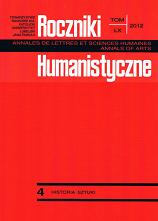"Zamieszkują kraje bardzo od siebie dalekie, ale duchem są sobie bliscy". Z kręgu badań nad związkami polsko-weneckimi w czasach jagiellońskich
„They live in faraway countries, but their spirits are close to one another”. From the circle of studies of Polish-Venetian relations (...)
Author(s): Ewelina Lilia PolańskaSubject(s): Cultural history
Published by: Towarzystwo Naukowe KUL & Katolicki Uniwersytet Lubelski Jana Pawła II
Keywords: Venice; Poland; Jagiellonian dynasty; political-diplomatic relation; court; culture; church; science; art; Wenecja; Polska; Jagiellonowie; relacje dyplomatyczne; dwór; kultura; kościół; nauka; sztuka
Summary/Abstract: As soon as the Middle Ages Poland established contacts with the Republic of Venice. The origin of the contacts should be looked for in the ecclesiastical-organizational as well as political-diplomatic relations. In the field of diplomacy both the republics were brought close by the issue of the Turkish threat and their joint work against the Habsburg monarchy. Constant contacts were also seen in the sphere of trade. From the Veneto region cloths, precious stones, glass and books were imported to the Jagiellonian state. Poland sold Polish cochineal, skins, fur coats, corn. The Polish-Lithuanian Commonwealth attracted Venetians with various social statuses; and it was not infrequent that they settled here for good. There were merchants, artisans, musicians, medicine doctors, clergymen and people of other trades between them. They entered court, church and bourgeois structures. Migration of the people coming from Veneto gathered momentum at the beginning of the 16th century, along with the development of the Renaissance. Artists – goldsmiths, architects, sculptors – came, as they were employed at the royal court and in magnate estates. Various artistic items were imported from Venice to Poland. Poles willingly travelled to the town on the lagoons and they expressed their delight with it in poems, memoirs and letters. A lot of outstanding Poles studied in Padua – a superb center of European academic thought. The Commonwealth of Both Nations and the Most Serene Republic of Venice were joined by affinities in a variety of fields of broadly understood culture. There was a constant flow of people, ideas, goods and works of art between them.
Journal: Roczniki Humanistyczne
- Issue Year: 60/2012
- Issue No: 04
- Page Range: 365-395
- Page Count: 31
- Language: Polish

